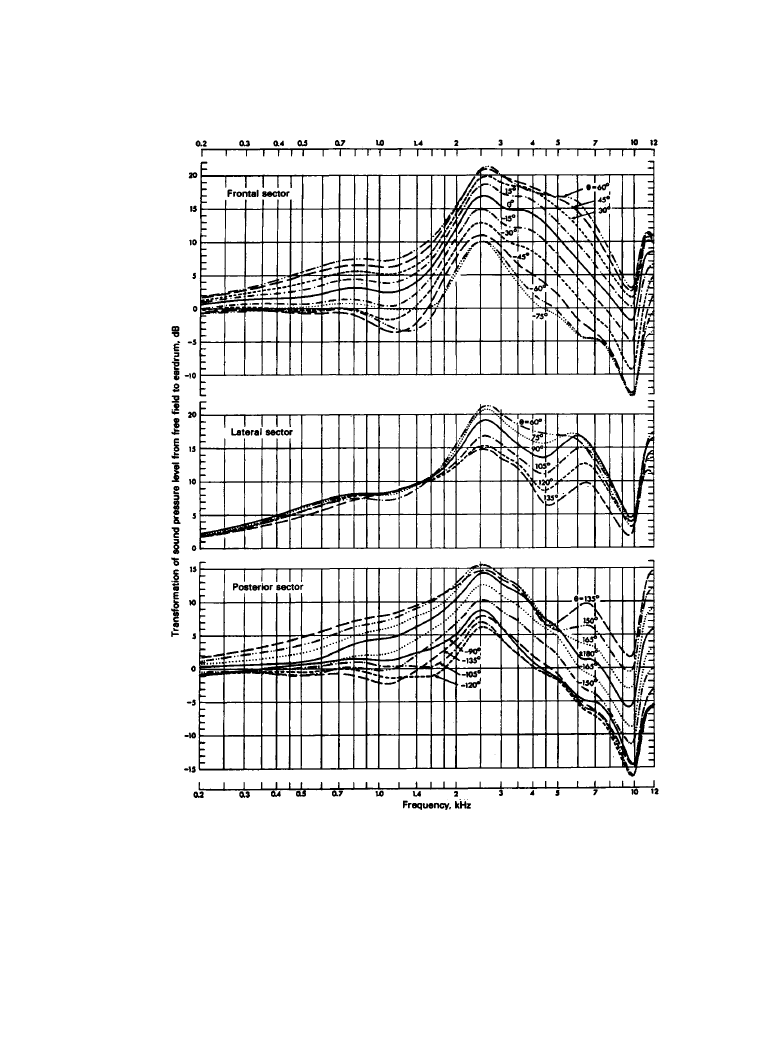ВУЗ: Казахская Национальная Академия Искусств им. Т. Жургенова
Категория: Книга
Дисциплина: Не указана
Добавлен: 03.02.2019
Просмотров: 21578
Скачиваний: 19

The Physical Nature of Hearing 1-51
1.4.3c
Acoustic Reflex
One of the less-known features of hearing is the acoustic reflex, an involuntary activation of the
middle-ear muscles in response to sound and some bodily functions. These tiny muscles alter the
transmission of sound energy through the middle ear, changing the quantity and quality of the
sound that reaches the inner ear. As the muscles tighten, there may be a slight reduction in the
overall sound level reaching the inner ear, but mainly there is a change in spectral balance as the
low frequencies are rolled off. Below approximately 1 kHz the attenuation is typically 5 to 10dB,
but it can be as much as 30 dB.
The reflex is activated by sounds above 80- to 85-dB SPL, which led to the early notion that it
was a protective mechanism; however, the most hazardous sounds are at frequencies that are little
affected by the reflex, and, furthermore, the reflex is too slow to block the passage of loud tran-
sients. The reflex activates rather slowly, in 10 to 20 ms for loud sounds and up to 150 ms for
sounds near the activation threshold; then, after an interval, it slowly relaxes. Obviously there
have to be other reasons for its existence. Although there is still some speculation as to its pur-
pose, the fact that it is automatically activated when we talk and when we chew suggests that part
of the reason is simply to reduce the auditory effects of our own voice and eating sounds.
Some people can activate the reflex voluntarily, and they report a reduction in the loudness of
low frequencies during the period of activation. The behavior of the reflex also appears to depend
on the state of the listener's attention to the sound itself This built-in tone control clearly is a
complication in sound quality assessments since the spectral balance appears to be a function of
sound level, the pattern of sound-level fluctuations in time, and the listener's attitude or attention
to the sound.
1.4.3d
Pitch
Pitch is the subjective attribute of frequency, and while the basic correspondence between the
two domains is obvious—low pitch to low frequencies and high pitch to high frequencies—the
detailed relationships are anything but simple.
Fortunately waveforms that are periodic, however complex they may be, tend to be judged as
having the same pitch as sine waves of the same repetition frequency. In other words, when a sat-
isfactory pitch match has been made, the fundamental frequency of a complex periodic sound
and a comparison sinusoid will normally be found to have the same frequency.
The exceptions to this simple rule derive from those situations where there is no physical
energy at the frequency corresponding to the perceived pitch. Examples of pitch being associated
with a missing fundamental are easily demonstrated by using groups of equally spaced tones,
such as 100, 150, and 200 Hz, and observing that the perceived pitch corresponds to the differ-
ence frequency, 50 Hz. Common experience with sound reproducers, such as small radios, that
have limited low-frequency bandwidth, illustrates the strength of the phenomenon, as do experi-
ences with musical instruments, such as some low-frequency organ sounds, that may have little
energy at the perceived fundamental frequency.
Scientifically, pitch has been studied on a continuous scale, in units of mels. It has been found
that there is a highly nonlinear relationship between subjectively judged ratios of pitch and the
corresponding ratios of frequency, with the subjective pitch interval increasing in size with
increasing frequency. All this, though, is of little interest to traditional musicians, who have orga-
nized the frequency domain into intervals having special tonal relationships. The octave is par-
ticularly notable because of the subjective similarity of sounds spaced an octave apart and the
Downloaded from Digital Engineering Library @ McGraw-Hill (www.digitalengineeringlibrary.com)
Copyright © 2004 The McGraw-Hill Companies. All rights reserved.
Any use is subject to the Terms of Use as given at the website.
The Physical Nature of Hearing

1-52 Principles of Sound and Hearing
fact that these sounds commonly differ in frequency by factors of 2. The musical fifth is a simi-
larly well-defined relationship, being a ratio of 3:2 in repetition frequencies. These and the other
intervals used in musical terminology gain meaning as one moves away from sine waves, with
their one-frequency purity, into the sounds of musical instruments with their rich collection of
overtones, many of which are harmonically related. With either pure tones [10] or some instru-
mental sounds in which not all the overtones are exactly harmonically related, the subjective
octave may differ slightly from the physical octave; in the piano this leads to what is called
stretched tuning [11].
The incompatibility of the mel scale of pitch and the hierarchy of musical intervals remains a
matter for discussion. These appear to be quite different views of the same phenomenon, with
some of the difference being associated with the musical expertise of listeners. It has been sug-
gested, for example, that the mel scale might be better interpreted as a scale of brightness rather
than one of pitch [12]. With periodic sounds brightness and pitch are closely related, but there are
sounds, such as bells, hisses, and clicks, that do not have all the properties of periodic sounds and
yet convey enough of a sense of pitch to enable tunes to be played with them, even though they
cannot be heard as combining into chords or harmony. In these cases, the impressions of bright-
ness and pitch seem to be associated with a prominence of sound energy in a band of frequencies
rather than with any of the spectral components (partials, overtones, or harmonics) that may be
present in the sound. A separate confirmation of this concept of brightness is found in subjective
assessments of reproduced sound quality, where there appears to be a perceptual dimension
along a continuum of “darkness” to “brightness” in which brightness is associated with a fre-
quency response that rises toward the high frequencies or in which there are peaks in the treble
[13]. At this, we reach a point in the discussion where it is more relevant to move into a different
but related domain.
1.4.3e
Timbre, Sound Quality, and Perceptual Dimensions
Sounds may be judged to have the same subjective dimensions of loudness and pitch and yet
sound very different from one another. This difference in sound quality, known as timbre in
musical terminology, can relate to the tonal quality of sounds from specific musical instruments
as they are played in live performance, to the character of tone imparted to all sounds processed
through a system of recording and reproduction, and to the tonal modifications added by the
architectural space within which the original performance or a reproduction takes place. Timbre
is, therefore, a matter of fundamental importance in audio, since it can be affected by almost any-
thing that occurs in the production, processing, storage, and reproduction of sounds.
Timbre has many dimensions, not all of which have been confidently identified and few of
which have been related with any certainty to the corresponding physical attributes of sound.
There is, for example, no doubt that the shape and composition of the frequency spectrum of the
sound are major factors, as are the temporal behaviors of individual elements comprising the
spectrum, but progress has been slow in identifying those measurable aspects of the signal that
correlate with specific perceived dimensions, mainly because there are so many interactions
between the dimensions themselves and between the physical and psychological factors underly-
ing them.
The field of electronic sound synthesis has contributed much to the understanding of why cer-
tain musical instruments sound the way they do, and from this understanding have followed
devices that permit continuous variations of many of the sound parameters. The result has been
Downloaded from Digital Engineering Library @ McGraw-Hill (www.digitalengineeringlibrary.com)
Copyright © 2004 The McGraw-Hill Companies. All rights reserved.
Any use is subject to the Terms of Use as given at the website.
The Physical Nature of Hearing

The Physical Nature of Hearing 1-53
progressively better imitations of acoustical instruments in electronic simulations, as well as an
infinite array of new “instruments” exhibiting tonal colors, dynamics, and emotional connota-
tions that are beyond the capability of traditional instruments. At the same time as this expansion
of timbral variety is occurring on one front of technical progress, there is an effort on another
front to faithfully preserve the timbre of real and synthesized instruments through the complex
process of recording and reproduction. The original intentions of high-fidelity reproduction exist
today in spite of the manifest abuses of the term in the consumer marketplace.
A fundamental problem in coming to grips with the relationship between the technical
descriptions of sounds and the perception of timbre is in establishing some order in the choice
and quantitative evaluation of words and phrases used by listeners to describe aspects of sound
quality. Some of the descriptors are fairly general in their application and seem to fall naturally to
quantification on a continuous scale from say, “dull” to “bright” or from “full” to “thin.” Others,
though, are specific to particular instruments or lapse into poetic portrayals of the evoked emo-
tions.
From carefully conducted assessments of reproduced sound quality involving forms of multi-
variate statistical analysis, it has become clear that the extensive list can be reduced to a few rel-
atively independent dimensions. As might be expected, many of the descriptors are simply
different ways of saying the same thing, or they are responses to different perceptual manifesta-
tions of the same physical phenomenon.
From such analyses can come useful clarifications of apparently anomalous results since
these responses need not be unidirectional. For example, a relatively innocent rise in the high-
frequency response of a sound reproducer might be perceived as causing violins to sound
unpleasantly strident but cymbals to sound unusually clear and articulate. A nice sense of air and
space might be somewhat offset by an accentuation of background hiss and vocal sibilants, and
so on.
Inexperienced listeners tend to concentrate unduly on a few of the many descriptors that come
to mind while listening, while slightly more sophisticated subjects may become confused by the
numerous contradictory indications. Both groups, for different reasons, may fail to note that
there is but a single underlying technical flaw. The task of critical listening is one that requires a
broad perspective and an understanding of the meaning and relative importance of the many tim-
bral clues that a varied musical program can reveal. Trained and experienced listeners tend to
combine timbral clues in a quest for logical technical explanations for the perceived effects.
However, with proper experimental controls and the necessary prompting through carefully pre-
pared instructions and a questionnaire, listeners with little prior experience can arrive at similar
evaluations of accuracy without understanding the technical explanations [14].
The following list of perceptual dimensions is derived from the work of Gabrielsson and vari-
ous colleagues [13, 15], and is the basis for listening questionnaires used extensively by those
workers and the author [14]. The descriptions are slightly modified from the original [13].
•
Clarity, or definition: This dimension is characterized by adjectives such as clear, well
defined, distinct, clean or pure, and rich in details or detailed, as opposed to adjectives such as
diffuse, muddy or confused, unclear, blurred, noisy, rough, harsh, or sometimes rumbling,
dull, and faint. High ratings in this dimension seem to require that the reproduction system
perform well in several respects, exhibiting a wide frequency range, flat frequency response,
and low nonlinear distortion. Systems with limited bandwidth, spectral irregularities due to
resonances, or audible distortion receive lower ratings. Low-frequency spectral emphasis
seems also to be detrimental to performance in this dimension, resulting in descriptions of
Downloaded from Digital Engineering Library @ McGraw-Hill (www.digitalengineeringlibrary.com)
Copyright © 2004 The McGraw-Hill Companies. All rights reserved.
Any use is subject to the Terms of Use as given at the website.
The Physical Nature of Hearing

1-54 Principles of Sound and Hearing
rumbling, for the obvious reason, and dullness, probably due to the upward masking effects of
the strong low frequencies. Increased sound levels result in increased clarity and definition.
•
Sharpness, or hardness, versus softness: Adjectives such as sharp, hard, shrill, screaming,
pointed, and clashing are associated with this dimension, contrasted with the opposite quali-
ties of soft, mild, calm or quiet, dull, and subdued. A rising high-frequency response or prom-
inent resonances in the high-frequency region can elicit high ratings in this dimension, as can
certain forms of distortion. A higher or lower sound level also contributes to movement
within this dimension, with reduced levels enhancing the aspect of softness.
•
Brightness versus darkness: This dimension is characterized by the adjective bright, as
opposed to dark, rumbling, dull, and emphasized bass. There appears to be a similar relation-
ship between this dimension and the physical attributes of the sound system as exists with the
preceding dimension, sharpness, or hardness, versus softness. In experiments, the two dimen-
sions sometimes appear together and sometimes separately. The sense of pitch associated
with brightness might be a factor in distinguishing between these two dimensions.
•
Fullness versus thinness: This dimension also can appear in combination with brightness ver-
sus darkness, and there are again certain similarities in the relationship to measured spectrum
balance and smoothness. There appears to be an association with the bandwidth of the sys-
tem, especially at the low frequencies, and with sound level. It seems possible that this dimen-
sion is a representation of one encountered elsewhere as volume, which has been found to
increase with increasing sound level but to decrease with increasing frequency.
•
Spaciousness: Almost self-explanatory, this dimension elicits expressions of spacious, airy,
wide, and open, as opposed to closed or shut up, narrow, and dry. The phenomenon appears to
be related to poorly correlated sounds at the two ears of the listener. Other aspects of spa-
ciousness are related to the spectrum of the reproduced sound. Gabrielsson points out that
increased treble response enhances spaciousness, while reducing the bandwidth encourages a
closed or shut-up impression. It is well known that the directional properties of the external
ear (Figure 1.4.5) encode incoming sounds with spectral cues that can be significant influ-
ences in sound localization [16]. One such cue is a moving spectral notch and an increase in
the sound level reaching the eardrum over the band from 5 to 10 kHz for progressively ele-
vated sources (Figure 1.4.6). The appropriate manipulation of the sound spectrum in this fre-
quency region can alone create impressions of height [17, 18] and, in this sense, alter the
impression of spaciousness. It is worthy of note that the dimension of spaciousness is clearly
observed in monophonic as well as stereophonic reproductions, indicating that it is a rather
fundamental aspect of sound quality [13, 19].
•
Nearness: Differences in the apparent proximity of sound sources are regularly observed in
listening tests. It is clear that sound level affects perception of distance, especially for sounds
such as the human voice that are familiar to listeners. Evidence from other studies indicates
that impressions of distance are also influenced by the relationship between the direct, early-
reflected, and reverberant sounds and the degree of coherence that exists in these sounds as
they appear at the listener's ears [17].
•
Absence of extraneous sounds: This dimension refers to nonmusical sounds that either exist in
the original program material and are accentuated by aspects of the reproducer (such as tape
hiss being aggravated by a treble boost) or are generated within the device itself (such as elec-
tronic amplifier clipping or mechanical noises from a loudspeaker).
Downloaded from Digital Engineering Library @ McGraw-Hill (www.digitalengineeringlibrary.com)
Copyright © 2004 The McGraw-Hill Companies. All rights reserved.
Any use is subject to the Terms of Use as given at the website.
The Physical Nature of Hearing

The Physical Nature of Hearing 1-55
Figure 1.4.5
Family of curves showing the transformation of sound pressure level from the free
field to the eardrum in the horizontal plane as a function of frequency, averaged over many listen-
ers in several independent studies. The horizontal angles are referred to zero (the forward direc-
tion) and increase positively toward the ear in which the measurement is made and negatively
away from it. (
From [27]. Used with permission.)
Downloaded from Digital Engineering Library @ McGraw-Hill (www.digitalengineeringlibrary.com)
Copyright © 2004 The McGraw-Hill Companies. All rights reserved.
Any use is subject to the Terms of Use as given at the website.
The Physical Nature of Hearing